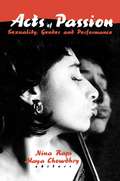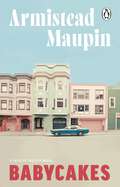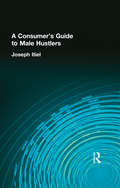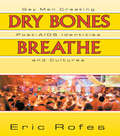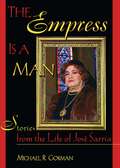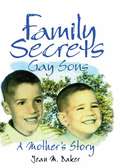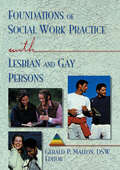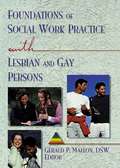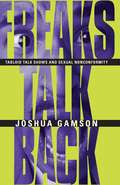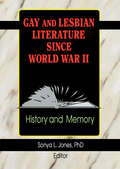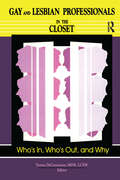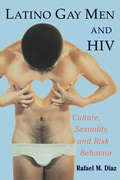- Table View
- List View
Acts of Passion: Sexuality, Gender, and Performance
by Nina Rapi Maya ChowdhryThe first volume to focus exclusively on lesbian performance work, Acts of Passion: Sexuality, Gender, and Performance draws on the experiences and expertise of a wide range of lesbian practitioners and theorists to explore the impact and influences of sexuality and gender on performance. It examines essays, dialogues, and performance texts from theater directors, performers, theorists, playwrights, and performance writers against social and cultural constructs and performance theories to produce a diverse and challenging portrait of lesbian live performance art. The book’s penetrating scope covers drag queens, lesbian vampires, representations of lesbian sex, solo artists, the art of collaboration, lesbian aesthetics, and lesbian playwrights writing straight and illustrates why live performance is one of the most dynamic forums in which women can create, control, and produce their work without artistic constraint.Acts of Passion explodes binary definitions of gender and sexuality by destabilizing familiar notions of the ‘real’and creating new production values and aesthetics in the process. The relationships between experience and expression, sexuality and cultural placing, context and artistic control, representation and self-representation become clearer as the book discusses: the manner in which women are represented as absent in the signifying system of patriarchal society how questions of purity, ‘authenticity,’and self-definition complicate the field of representation the power of lesbian dance performance to make the lesbian body culturally visible several ‘new wave’performers--creating work, getting seen, showing flesh, doing politics, and making money the projections, preconceptions, expectations, and general baggage attached to the performing lesbian body what the term ‘lesbian playwright’means within contemporary culture ‘It’s Queer Up North’--a British National Arts Organization the arguments for and against mainstreaming lesbian performanceAnyone interested in theater and performance, cultural studies, gender issues, and the politics of ‘positive representation’--whether playwright, performer, director, writer, academic, student, or theatre goer--will find Acts of Passion a powerful step in wrenching the power of representation away from the dominant culture. Defiant, saucy, sexy, and smart, the contributors appropriate their own spaces, identities, crafts, and languages, both within this book and without.
Acts of Passion: Sexuality, Gender, and Performance
by Nina Rapi Maya ChowdhryThe first volume to focus exclusively on lesbian performance work, Acts of Passion: Sexuality, Gender, and Performance draws on the experiences and expertise of a wide range of lesbian practitioners and theorists to explore the impact and influences of sexuality and gender on performance. It examines essays, dialogues, and performance texts from theater directors, performers, theorists, playwrights, and performance writers against social and cultural constructs and performance theories to produce a diverse and challenging portrait of lesbian live performance art. The book’s penetrating scope covers drag queens, lesbian vampires, representations of lesbian sex, solo artists, the art of collaboration, lesbian aesthetics, and lesbian playwrights writing straight and illustrates why live performance is one of the most dynamic forums in which women can create, control, and produce their work without artistic constraint.Acts of Passion explodes binary definitions of gender and sexuality by destabilizing familiar notions of the ‘real’and creating new production values and aesthetics in the process. The relationships between experience and expression, sexuality and cultural placing, context and artistic control, representation and self-representation become clearer as the book discusses: the manner in which women are represented as absent in the signifying system of patriarchal society how questions of purity, ‘authenticity,’and self-definition complicate the field of representation the power of lesbian dance performance to make the lesbian body culturally visible several ‘new wave’performers--creating work, getting seen, showing flesh, doing politics, and making money the projections, preconceptions, expectations, and general baggage attached to the performing lesbian body what the term ‘lesbian playwright’means within contemporary culture ‘It’s Queer Up North’--a British National Arts Organization the arguments for and against mainstreaming lesbian performanceAnyone interested in theater and performance, cultural studies, gender issues, and the politics of ‘positive representation’--whether playwright, performer, director, writer, academic, student, or theatre goer--will find Acts of Passion a powerful step in wrenching the power of representation away from the dominant culture. Defiant, saucy, sexy, and smart, the contributors appropriate their own spaces, identities, crafts, and languages, both within this book and without.
Babycakes: Tales of the City 4 (Tales of the City #4)
by Armistead MaupinThe fourth novel in the beloved Tales of the City series, Armistead Maupin’s best-selling San Francisco saga.‘A consummate entertainer who has made a generation laugh.... It is Maupin's Dickensian gift to be able to render love convincingly’ Edmund White, Times Literary Supplement____________________When an ordinary househusband and his ambitious wife decide to start a family, they discover there’s more to making a baby than meets the eye. Help arrives in the form of a grieving gay neighbour, a visiting monarch, and the dashing young lieutenant who defects from her yacht. Bittersweet and profoundly affecting, Babycakes was the first piece of fiction to acknowledge the arrival of AIDS.Hurdling barriers both social and sexual, Maupin leads the eccentric tenants of Barbary Lane through heartbreak and triumph, through nail-biting terrors and gleeful coincidences in 1970s San Francisco. The result is a glittering and addictive comedy of manners that continues to beguile new generations of readers.
A Consumer's Guide to Male Hustlers
by Joseph ItielA Consumer’s Guide to Male Hustlers gives you exciting insight into all you ever wanted to know about hustlers but were too embarrassed to ask. You’ll find answers to questions such as where and how to find hustlers, how much to pay them, and how to make it an experience that is satisfying to both parties. Author Joseph Itiel shares with readers his personal experiences and observations, describing his dealings with hustlers, over a period of about 35 years, in many different countries.Throughout A Consumer’s Guide to Male Hustlers, Itiel narrates personal anecdotes, lending an intimate dimension to his general observations. He describes the hustler scene in the United States and abroad, dispelling many erroneous notions about hustlers by addressing such topics as: under what circumstances sex-for-money arrangements are exploitative (a comparison of male hustlers and female prostitutes) emotional involvement and control between clients and hustlers the notion that hustlers are only for the wealthy whether or not hustlers are likely carriers of sexually transmitted diseases whether or not it is dangerous to pick up hustlers why hustlers hustle the differences between street hustlers, models (or escorts), and masseurs legal issues associated with hustling regular sessions with hustlers as an emotional and libidinal sedativeIt is the contention of the author that hustlers are an under-used resource in the gay community, especially valuable to those with a vigorous sex appetite but no steady partner. This opportunity is often shunned because potential clients feel guilty about hiring hustlers. The author hopes that by reading this book, you will come to understand that the hustler experience, meeting with hustlers regularly, can be mutually exciting and satisfying for both parties.
A Consumer's Guide to Male Hustlers
by Joseph ItielA Consumer’s Guide to Male Hustlers gives you exciting insight into all you ever wanted to know about hustlers but were too embarrassed to ask. You’ll find answers to questions such as where and how to find hustlers, how much to pay them, and how to make it an experience that is satisfying to both parties. Author Joseph Itiel shares with readers his personal experiences and observations, describing his dealings with hustlers, over a period of about 35 years, in many different countries.Throughout A Consumer’s Guide to Male Hustlers, Itiel narrates personal anecdotes, lending an intimate dimension to his general observations. He describes the hustler scene in the United States and abroad, dispelling many erroneous notions about hustlers by addressing such topics as: under what circumstances sex-for-money arrangements are exploitative (a comparison of male hustlers and female prostitutes) emotional involvement and control between clients and hustlers the notion that hustlers are only for the wealthy whether or not hustlers are likely carriers of sexually transmitted diseases whether or not it is dangerous to pick up hustlers why hustlers hustle the differences between street hustlers, models (or escorts), and masseurs legal issues associated with hustling regular sessions with hustlers as an emotional and libidinal sedativeIt is the contention of the author that hustlers are an under-used resource in the gay community, especially valuable to those with a vigorous sex appetite but no steady partner. This opportunity is often shunned because potential clients feel guilty about hiring hustlers. The author hopes that by reading this book, you will come to understand that the hustler experience, meeting with hustlers regularly, can be mutually exciting and satisfying for both parties.
Dry Bones Breathe: Gay Men Creating Post-AIDS Identities and Cultures
by Eric RofesDry Bones Breathe: Gay Men Creating Post-AIDS Identities and Cultures breaks new ground in offering an original and insightful interpretation of gay men’s shifting experience of the AIDS epidemic. From Dry Bones Breathe, you’ll gain a deeper understanding of current community debates focused on circuit parties, unprotected sex, and gay men’s sexual cultures, and you will learn how social, political, and biomedical changes are dramatically transforming gay identities and cultures.Dry Bones Breathe is Eric Rofes’explosive follow-up to Reviving the Tribe, a book which broke open debates in gay communities around the world about sex, identity, and gay men’s relationship to AIDS. In this volume, Rofes contends that most gay men no longer experience AIDS as the crisis they did during the 1980s. Gay men often attribute this shift to the advent of protozoa inhibitors, but Rofes explains how other factors, including the epidemic’s predicted trajectory, new treatments for opportunistic infections, the passage of time, and the increasing diversity of gay men inhabiting communities throughout the country have set in motion the transformation of gay life. AIDS organizations and gay leaders, however, continue to assert that gay men experience AIDS as an emergency, resulting in a tremendous dissonance between gay leaders and their communities. In the midst of this controversy, Dry Bones Breathe lets you share in stories of hope and recovery and a new vision for AIDS work that demands a radical redesign of prevention, care, and activism. Dry Bones Breathe tackles several other issues concerning the powerful shifts occurring in gay communities and cultures by: explaining why an understanding of the terms “post-AIDS” and “post-crisis” is crucial to interpreting contemporary gay male cultures and what Australian prevention theorists have to offer gay men in the United States describing the “Protozoa Moment” and exploring how a dangerous obsession with pharmaceuticals is leading many to mistakenly attribute all changes in gay men’s cultures to combination therapies examining the writings of Larry Kramer, Andrew Sullivan, Michelangelo Signorile, and Gabriel Rightly to illustrate how the crisis construct has unleashed a backlash against gay sexual cultures discussing the dramatic diminution in gay men’s AIDS-related deaths in epicenter cities and the impact of shrinking obituary pages on gay men’s mental health exploring the diverse relationships to the epidemic forged by young gay men, gay men of color, gay men from rural or small towns, and middle-aged men not infected with HI detailing how HI prevention and service organizations targeting gay men must redesign their mission and restructure their work In response to continuing efforts to direct gay men back into a state of emergency, Dry Bones Breathe suggests that long-term prevention efforts must be constructed around something other than a crisis. While AIDS organizations look at gay men’s diminished participation in AIDS activism, Rofes argues that these organizations should face how they have distanced themselves from the reality of most gay men’s lives. From stories and experiences full of hope, anger, sadness, and strength, Dry Bones Breathe will teach you about gay men who no longer base their identities and cultures solely around AIDS.
Dry Bones Breathe: Gay Men Creating Post-AIDS Identities and Cultures
by Eric RofesDry Bones Breathe: Gay Men Creating Post-AIDS Identities and Cultures breaks new ground in offering an original and insightful interpretation of gay men’s shifting experience of the AIDS epidemic. From Dry Bones Breathe, you’ll gain a deeper understanding of current community debates focused on circuit parties, unprotected sex, and gay men’s sexual cultures, and you will learn how social, political, and biomedical changes are dramatically transforming gay identities and cultures.Dry Bones Breathe is Eric Rofes’explosive follow-up to Reviving the Tribe, a book which broke open debates in gay communities around the world about sex, identity, and gay men’s relationship to AIDS. In this volume, Rofes contends that most gay men no longer experience AIDS as the crisis they did during the 1980s. Gay men often attribute this shift to the advent of protozoa inhibitors, but Rofes explains how other factors, including the epidemic’s predicted trajectory, new treatments for opportunistic infections, the passage of time, and the increasing diversity of gay men inhabiting communities throughout the country have set in motion the transformation of gay life. AIDS organizations and gay leaders, however, continue to assert that gay men experience AIDS as an emergency, resulting in a tremendous dissonance between gay leaders and their communities. In the midst of this controversy, Dry Bones Breathe lets you share in stories of hope and recovery and a new vision for AIDS work that demands a radical redesign of prevention, care, and activism. Dry Bones Breathe tackles several other issues concerning the powerful shifts occurring in gay communities and cultures by: explaining why an understanding of the terms “post-AIDS” and “post-crisis” is crucial to interpreting contemporary gay male cultures and what Australian prevention theorists have to offer gay men in the United States describing the “Protozoa Moment” and exploring how a dangerous obsession with pharmaceuticals is leading many to mistakenly attribute all changes in gay men’s cultures to combination therapies examining the writings of Larry Kramer, Andrew Sullivan, Michelangelo Signorile, and Gabriel Rightly to illustrate how the crisis construct has unleashed a backlash against gay sexual cultures discussing the dramatic diminution in gay men’s AIDS-related deaths in epicenter cities and the impact of shrinking obituary pages on gay men’s mental health exploring the diverse relationships to the epidemic forged by young gay men, gay men of color, gay men from rural or small towns, and middle-aged men not infected with HI detailing how HI prevention and service organizations targeting gay men must redesign their mission and restructure their work In response to continuing efforts to direct gay men back into a state of emergency, Dry Bones Breathe suggests that long-term prevention efforts must be constructed around something other than a crisis. While AIDS organizations look at gay men’s diminished participation in AIDS activism, Rofes argues that these organizations should face how they have distanced themselves from the reality of most gay men’s lives. From stories and experiences full of hope, anger, sadness, and strength, Dry Bones Breathe will teach you about gay men who no longer base their identities and cultures solely around AIDS.
The Empress Is a Man: Stories from the Life of José Sarria
by Michael R GormanYou may be familiar with the tremendous life achievements of José Sarria, an integral player in the gay rights movement, but never before have you heard the intimate details of his incredible life as they are portrayed here. In The Empress Is a Man: Stories from the Life of José Sarria (winner of the Lammy Award in the transgender category), Michael Gorman exposes Sarria’s life in a frank manner and with a unique storytelling ability that simultaneously causes amusement and sadness. Sarria’s amazing life story tells of his perserverance to advance the cause of equality for gay citizens.At a time when gays were arrested, institutionalized, and castrated, Sarria did not try to hide his beliefs and convictions. Sarria was ahead of his time, becoming a significant figure in gay history and culture. You’ll find The Empress Is a Man fascinating as you read about the life of this truly courageous, outrageous, and remarkable man. Some of Sarria’s experiences and achievements you’ll read about include: being the first openly gay male to run for political office being one of America’s most important female impersonators entertaining throughout the world, live and on film postitively affecting the gay community founding an extremely successful charity fundraising organization being featured in a PBS documentary serving in the Army in The Battle of the Bulge in WWIIUntil recently, gay and lesbian stories were published in very limited venues and often at great personal risk, forcing knowledge of this history to be passed down orally. The Empress Is a Man reflects this tradition by telling much of the story in Sarria’s own words. Adding to the enjoyment and originality of this book is a structure similar to the dramatic style of a play or novel. Each section ends with an exciting climax, although the book is chronological in order. The Empress Is a Man is an untraditional book about an untraditional man.
The Empress Is a Man: Stories from the Life of José Sarria
by Michael R GormanYou may be familiar with the tremendous life achievements of José Sarria, an integral player in the gay rights movement, but never before have you heard the intimate details of his incredible life as they are portrayed here. In The Empress Is a Man: Stories from the Life of José Sarria (winner of the Lammy Award in the transgender category), Michael Gorman exposes Sarria’s life in a frank manner and with a unique storytelling ability that simultaneously causes amusement and sadness. Sarria’s amazing life story tells of his perserverance to advance the cause of equality for gay citizens.At a time when gays were arrested, institutionalized, and castrated, Sarria did not try to hide his beliefs and convictions. Sarria was ahead of his time, becoming a significant figure in gay history and culture. You’ll find The Empress Is a Man fascinating as you read about the life of this truly courageous, outrageous, and remarkable man. Some of Sarria’s experiences and achievements you’ll read about include: being the first openly gay male to run for political office being one of America’s most important female impersonators entertaining throughout the world, live and on film postitively affecting the gay community founding an extremely successful charity fundraising organization being featured in a PBS documentary serving in the Army in The Battle of the Bulge in WWIIUntil recently, gay and lesbian stories were published in very limited venues and often at great personal risk, forcing knowledge of this history to be passed down orally. The Empress Is a Man reflects this tradition by telling much of the story in Sarria’s own words. Adding to the enjoyment and originality of this book is a structure similar to the dramatic style of a play or novel. Each section ends with an exciting climax, although the book is chronological in order. The Empress Is a Man is an untraditional book about an untraditional man.
Family Secrets: Gay Sons - A Mother's Story
by Jean M BakerAs a clinical psychologist, Jean Baker had always considered herself open-minded and tolerant, but found she wasn’t prepared for the revelation that her only two children were both gay. Family Secrets is an inspirational story of how she and her family learned to accept one another and overcome their internalized fears and prejudices as well as how they coped with a much greater challenge in their personal lives--HIV/AIDS. Family Secrets is more than a parenting memoir, however. It is a guide that draws upon research and scientific findings to capsize the myths and stereotypes that contribute to societal homophobia. It offers important insight into the developmental needs of gay children, and it discusses the issues faced by gay and lesbian youth and their families.Offering practical suggestions about how parents and schools can help gay, lesbian, and bisexual children grow up to be productive, psychologically healthy adults, Family Secrets discusses the effects of social prejudice and stigma on the social and emotional development of sexual minorities. As long as homophobia is running rampant in American society, gay children are going to be reluctant or afraid to confide in their parents, and parents will have trouble understanding and accepting homosexuality in their children. To end the secrecy and build open and healthy environments for all children and adolescents, this book discusses: tactics for reducing homophobia in non-gay youths promoting tolerance and understanding of sexual minorities at home and in school the effects an AIDS death has on families “coming out” about HIV/AIDS discussing homosexuality with your children, regardless of whether or not they are gay or lesbian sexual orientation and the interaction of biology with experienceBecause Family Secrets is written from the viewpoint of a parent/psychologist, it offers insights into the developmental needs of gay and lesbian children in a way that no other book has done. School counselors, psychologists, marriage and family counselors, teachers, school administrators, and the parents and siblings of gays and lesbians will all benefit from reading this honest, helpful, and encouraging book.
Family Secrets: Gay Sons - A Mother's Story
by Jean M BakerAs a clinical psychologist, Jean Baker had always considered herself open-minded and tolerant, but found she wasn’t prepared for the revelation that her only two children were both gay. Family Secrets is an inspirational story of how she and her family learned to accept one another and overcome their internalized fears and prejudices as well as how they coped with a much greater challenge in their personal lives--HIV/AIDS. Family Secrets is more than a parenting memoir, however. It is a guide that draws upon research and scientific findings to capsize the myths and stereotypes that contribute to societal homophobia. It offers important insight into the developmental needs of gay children, and it discusses the issues faced by gay and lesbian youth and their families.Offering practical suggestions about how parents and schools can help gay, lesbian, and bisexual children grow up to be productive, psychologically healthy adults, Family Secrets discusses the effects of social prejudice and stigma on the social and emotional development of sexual minorities. As long as homophobia is running rampant in American society, gay children are going to be reluctant or afraid to confide in their parents, and parents will have trouble understanding and accepting homosexuality in their children. To end the secrecy and build open and healthy environments for all children and adolescents, this book discusses: tactics for reducing homophobia in non-gay youths promoting tolerance and understanding of sexual minorities at home and in school the effects an AIDS death has on families “coming out” about HIV/AIDS discussing homosexuality with your children, regardless of whether or not they are gay or lesbian sexual orientation and the interaction of biology with experienceBecause Family Secrets is written from the viewpoint of a parent/psychologist, it offers insights into the developmental needs of gay and lesbian children in a way that no other book has done. School counselors, psychologists, marriage and family counselors, teachers, school administrators, and the parents and siblings of gays and lesbians will all benefit from reading this honest, helpful, and encouraging book.
Foundations of Social Work Practice with Lesbian and Gay Persons
by Gerald P MallonFocusing on the pragmatic aspects of social work with gay and lesbian persons, this book offers a knowledge base of practice that will better prepare students and practitioners for working more competently and effectively with lesbians and gay men. Written by scholars and practitioners in the social work profession, Foundations of Social Work Practice with Lesbian and Gay Persons teaches you how to develop practice approaches that are sensitive to issues of sexual orientation as well as how to work with this population in the contexts of practice with individuals, couples, families, groups, communities, and organizations. The book’s sensible strategies and case studies provide you with critical information that will help you deal with homophobia and heterocentrism and enact a professional commitment to pursuing economic and social equality for diverse and at-risk client populations.A foundation-level text on social work practice with gays and lesbians, this book is designed to provide social work students, academics, and practitioners with an understanding of the values and ethics fundamental to practice with this group of clients. Foundations of Social Work Practice with Lesbian and Gay Persons summarizes the variety of issues, dynamics, and techniques required to work effectively with gay and lesbian clients who are at different points in their development and life cycles. To further help you in your practice, it also discusses: providing skilled professional assistance to gay victims of hate crimes how homophobia can prevent lesbians and gay men from receiving adequate services the obstacles social workers sometimes face when trying to integrate the core set of professional values and ethical principles into their practice practitioner self-disclosure regarding sexual identity developmental milestones for lesbian and gay persons alcohol and substance abuse among lesbians family therapy concepts of fusion and enmeshment same gender socialization assessing issues of sexual expressionCounselors, social workers, and students and academics in gay and lesbian studies will find that Foundations of Social Work Practice with Lesbian and Gay Persons greatly expands the social work knowledge base to disrupt the impact of institutional, individualized, and internal homophobia on social workers, their clients, and the institutions in which social workers practice. Its flexible and creative treatment approaches to therapy with sexual minorities are sure to help you sensitize your therapeutic techniques and improve the quality of care you deliver.
Foundations of Social Work Practice with Lesbian and Gay Persons
by Gerald P MallonFocusing on the pragmatic aspects of social work with gay and lesbian persons, this book offers a knowledge base of practice that will better prepare students and practitioners for working more competently and effectively with lesbians and gay men. Written by scholars and practitioners in the social work profession, Foundations of Social Work Practice with Lesbian and Gay Persons teaches you how to develop practice approaches that are sensitive to issues of sexual orientation as well as how to work with this population in the contexts of practice with individuals, couples, families, groups, communities, and organizations. The book’s sensible strategies and case studies provide you with critical information that will help you deal with homophobia and heterocentrism and enact a professional commitment to pursuing economic and social equality for diverse and at-risk client populations.A foundation-level text on social work practice with gays and lesbians, this book is designed to provide social work students, academics, and practitioners with an understanding of the values and ethics fundamental to practice with this group of clients. Foundations of Social Work Practice with Lesbian and Gay Persons summarizes the variety of issues, dynamics, and techniques required to work effectively with gay and lesbian clients who are at different points in their development and life cycles. To further help you in your practice, it also discusses: providing skilled professional assistance to gay victims of hate crimes how homophobia can prevent lesbians and gay men from receiving adequate services the obstacles social workers sometimes face when trying to integrate the core set of professional values and ethical principles into their practice practitioner self-disclosure regarding sexual identity developmental milestones for lesbian and gay persons alcohol and substance abuse among lesbians family therapy concepts of fusion and enmeshment same gender socialization assessing issues of sexual expressionCounselors, social workers, and students and academics in gay and lesbian studies will find that Foundations of Social Work Practice with Lesbian and Gay Persons greatly expands the social work knowledge base to disrupt the impact of institutional, individualized, and internal homophobia on social workers, their clients, and the institutions in which social workers practice. Its flexible and creative treatment approaches to therapy with sexual minorities are sure to help you sensitize your therapeutic techniques and improve the quality of care you deliver.
Freaks Talk Back: Tabloid Talk Shows and Sexual Nonconformity
by Joshua GamsonUsing extensive interviews, hundreds of transcripts, focus-group discussions with viewers, and his own experiences as an audience member, Joshua Gamson argues that talk shows give much-needed, high-impact public visibility to sexual nonconformists while also exacerbating all sorts of political tensions among those becoming visible. With wit and passion, Freaks Talk Back illuminates the joys, dilemmas, and practicalities of media visibility. "This entertaining, accessible, sobering discussion should make every viewer sit up and ponder the effects and possibilities of America's daily talk-fest with newly sharpened eyes."—Publishers Weekly "Bold, witty. . . . There's a lot of empirical work behind this deceptively easy read, then, and it allows for the most sophisticated and complex analysis of talk shows yet."—Elayne Rapping, Women's Review of Books "Funny, well-researched, fully theorized. . . . Engaged and humane scholarship. . . . A pretty inspiring example of what talking back to the mass media can be."—Jesse Berrett, Village Voice "An extraordinarily well-researched volume, one of the most comprehensive studies of popular media to appear in this decade."—James Ledbetter, Newsday
Freaks Talk Back: Tabloid Talk Shows and Sexual Nonconformity
by Joshua GamsonUsing extensive interviews, hundreds of transcripts, focus-group discussions with viewers, and his own experiences as an audience member, Joshua Gamson argues that talk shows give much-needed, high-impact public visibility to sexual nonconformists while also exacerbating all sorts of political tensions among those becoming visible. With wit and passion, Freaks Talk Back illuminates the joys, dilemmas, and practicalities of media visibility. "This entertaining, accessible, sobering discussion should make every viewer sit up and ponder the effects and possibilities of America's daily talk-fest with newly sharpened eyes."—Publishers Weekly "Bold, witty. . . . There's a lot of empirical work behind this deceptively easy read, then, and it allows for the most sophisticated and complex analysis of talk shows yet."—Elayne Rapping, Women's Review of Books "Funny, well-researched, fully theorized. . . . Engaged and humane scholarship. . . . A pretty inspiring example of what talking back to the mass media can be."—Jesse Berrett, Village Voice "An extraordinarily well-researched volume, one of the most comprehensive studies of popular media to appear in this decade."—James Ledbetter, Newsday
Freaks Talk Back: Tabloid Talk Shows and Sexual Nonconformity
by Joshua GamsonUsing extensive interviews, hundreds of transcripts, focus-group discussions with viewers, and his own experiences as an audience member, Joshua Gamson argues that talk shows give much-needed, high-impact public visibility to sexual nonconformists while also exacerbating all sorts of political tensions among those becoming visible. With wit and passion, Freaks Talk Back illuminates the joys, dilemmas, and practicalities of media visibility. "This entertaining, accessible, sobering discussion should make every viewer sit up and ponder the effects and possibilities of America's daily talk-fest with newly sharpened eyes."—Publishers Weekly "Bold, witty. . . . There's a lot of empirical work behind this deceptively easy read, then, and it allows for the most sophisticated and complex analysis of talk shows yet."—Elayne Rapping, Women's Review of Books "Funny, well-researched, fully theorized. . . . Engaged and humane scholarship. . . . A pretty inspiring example of what talking back to the mass media can be."—Jesse Berrett, Village Voice "An extraordinarily well-researched volume, one of the most comprehensive studies of popular media to appear in this decade."—James Ledbetter, Newsday
Freaks Talk Back: Tabloid Talk Shows and Sexual Nonconformity
by Joshua GamsonUsing extensive interviews, hundreds of transcripts, focus-group discussions with viewers, and his own experiences as an audience member, Joshua Gamson argues that talk shows give much-needed, high-impact public visibility to sexual nonconformists while also exacerbating all sorts of political tensions among those becoming visible. With wit and passion, Freaks Talk Back illuminates the joys, dilemmas, and practicalities of media visibility. "This entertaining, accessible, sobering discussion should make every viewer sit up and ponder the effects and possibilities of America's daily talk-fest with newly sharpened eyes."—Publishers Weekly "Bold, witty. . . . There's a lot of empirical work behind this deceptively easy read, then, and it allows for the most sophisticated and complex analysis of talk shows yet."—Elayne Rapping, Women's Review of Books "Funny, well-researched, fully theorized. . . . Engaged and humane scholarship. . . . A pretty inspiring example of what talking back to the mass media can be."—Jesse Berrett, Village Voice "An extraordinarily well-researched volume, one of the most comprehensive studies of popular media to appear in this decade."—James Ledbetter, Newsday
Freaks Talk Back: Tabloid Talk Shows and Sexual Nonconformity
by Joshua GamsonUsing extensive interviews, hundreds of transcripts, focus-group discussions with viewers, and his own experiences as an audience member, Joshua Gamson argues that talk shows give much-needed, high-impact public visibility to sexual nonconformists while also exacerbating all sorts of political tensions among those becoming visible. With wit and passion, Freaks Talk Back illuminates the joys, dilemmas, and practicalities of media visibility. "This entertaining, accessible, sobering discussion should make every viewer sit up and ponder the effects and possibilities of America's daily talk-fest with newly sharpened eyes."—Publishers Weekly "Bold, witty. . . . There's a lot of empirical work behind this deceptively easy read, then, and it allows for the most sophisticated and complex analysis of talk shows yet."—Elayne Rapping, Women's Review of Books "Funny, well-researched, fully theorized. . . . Engaged and humane scholarship. . . . A pretty inspiring example of what talking back to the mass media can be."—Jesse Berrett, Village Voice "An extraordinarily well-researched volume, one of the most comprehensive studies of popular media to appear in this decade."—James Ledbetter, Newsday
Freaks Talk Back: Tabloid Talk Shows and Sexual Nonconformity
by Joshua GamsonUsing extensive interviews, hundreds of transcripts, focus-group discussions with viewers, and his own experiences as an audience member, Joshua Gamson argues that talk shows give much-needed, high-impact public visibility to sexual nonconformists while also exacerbating all sorts of political tensions among those becoming visible. With wit and passion, Freaks Talk Back illuminates the joys, dilemmas, and practicalities of media visibility. "This entertaining, accessible, sobering discussion should make every viewer sit up and ponder the effects and possibilities of America's daily talk-fest with newly sharpened eyes."—Publishers Weekly "Bold, witty. . . . There's a lot of empirical work behind this deceptively easy read, then, and it allows for the most sophisticated and complex analysis of talk shows yet."—Elayne Rapping, Women's Review of Books "Funny, well-researched, fully theorized. . . . Engaged and humane scholarship. . . . A pretty inspiring example of what talking back to the mass media can be."—Jesse Berrett, Village Voice "An extraordinarily well-researched volume, one of the most comprehensive studies of popular media to appear in this decade."—James Ledbetter, Newsday
Gay and Lesbian Literature Since World War II: History and Memory
by Sonya L JonesGay and Lesbian Literature Since World War II chronicles the multifaceted explosion of gay and lesbian writing that has taken place in the second half of the twentieth century. Encompassing a wide range of subject matter and a balance of gay and lesbian concerns, it includes work by established scholars as well as young theoreticians and archivists who have initiated new areas of investigation. The contributors’examinations of this rich literary period make it easy to view the half-century from 1948 to 1998 as the Queer Renaissance. Included in Gay and Lesbian Literature Since World War II are critical and social analyses of literary movements, novels, short fiction, periodicals, and poetry as well as a look at the challenges of establishing a repository for lesbian cultural history. Specific chapters in this groundbreaking work trace the development of gay poetry in America after World War II; examine how AIDS is represented in the first four Latino novels to deal with the subject matter; and chronicle the birth of lesbian-feminist publishing in the 1970s--showing how it created a flourishing gay literature in the 1980s and 1990s. Other chapters: outline the history of The Ladder from its initial publication in 1956 as the official vehicle of the Daughters of Bilitis to its final issue as a privately published literary magazine in 1972 examine Baldwin’s 1962 novel Another Country and discuss the complicated critical history of this work and its relation to Baldwin’s literary reputation--racial, sexual, and political factors are taken into account chart how Other Voices, Other Rooms, by Truman Capote, and The House of Breath, by William Goyen, reveal contradictory genderings of male homosexuality--suggesting an absence of a unified model of mid-twentieth-century male homosexuality argue that the 1976 novel Lover, by Bertha Harris, can be considered an exemplary novel within discussions of both postmodern fiction and lesbian theory. (The author calls for Harris to be added to the group of writers such as Wittig, Anzaldúa, Lorde, and Winterson, who are discussed within the context of a postmodern lesbian narrative.) examine the short fiction of Canadian lesbian novelist Jane Rule in an effort to shed light on lesbian creative practice in the homophobic climate of postwar North America argue for an understanding of Dale Peck’s novel Martin and John as an attempt to link two apparently different processes of import to contemporary male subjects through examination of the novel alongside selected passages from Nietzsche and Freud focus on the pragmatic issues of developing and maintaining accessible research venues from which to cultivate the study of racial and cultural diversity in lesbian lives Document the history of the Lesbian Herstory Archives, one of the first lesbian-specific collections in the world, from its birth in the early 1970s to the present.
Gay and Lesbian Literature Since World War II: History and Memory
by Sonya L JonesGay and Lesbian Literature Since World War II chronicles the multifaceted explosion of gay and lesbian writing that has taken place in the second half of the twentieth century. Encompassing a wide range of subject matter and a balance of gay and lesbian concerns, it includes work by established scholars as well as young theoreticians and archivists who have initiated new areas of investigation. The contributors’examinations of this rich literary period make it easy to view the half-century from 1948 to 1998 as the Queer Renaissance. Included in Gay and Lesbian Literature Since World War II are critical and social analyses of literary movements, novels, short fiction, periodicals, and poetry as well as a look at the challenges of establishing a repository for lesbian cultural history. Specific chapters in this groundbreaking work trace the development of gay poetry in America after World War II; examine how AIDS is represented in the first four Latino novels to deal with the subject matter; and chronicle the birth of lesbian-feminist publishing in the 1970s--showing how it created a flourishing gay literature in the 1980s and 1990s. Other chapters: outline the history of The Ladder from its initial publication in 1956 as the official vehicle of the Daughters of Bilitis to its final issue as a privately published literary magazine in 1972 examine Baldwin’s 1962 novel Another Country and discuss the complicated critical history of this work and its relation to Baldwin’s literary reputation--racial, sexual, and political factors are taken into account chart how Other Voices, Other Rooms, by Truman Capote, and The House of Breath, by William Goyen, reveal contradictory genderings of male homosexuality--suggesting an absence of a unified model of mid-twentieth-century male homosexuality argue that the 1976 novel Lover, by Bertha Harris, can be considered an exemplary novel within discussions of both postmodern fiction and lesbian theory. (The author calls for Harris to be added to the group of writers such as Wittig, Anzaldúa, Lorde, and Winterson, who are discussed within the context of a postmodern lesbian narrative.) examine the short fiction of Canadian lesbian novelist Jane Rule in an effort to shed light on lesbian creative practice in the homophobic climate of postwar North America argue for an understanding of Dale Peck’s novel Martin and John as an attempt to link two apparently different processes of import to contemporary male subjects through examination of the novel alongside selected passages from Nietzsche and Freud focus on the pragmatic issues of developing and maintaining accessible research venues from which to cultivate the study of racial and cultural diversity in lesbian lives Document the history of the Lesbian Herstory Archives, one of the first lesbian-specific collections in the world, from its birth in the early 1970s to the present.
Gay and Lesbian Professionals in the Closet: Who's In, Who's Out, and Why
by Teresa DecrescenzoThe closet takes its toll on its dwellers through their experiences of isolation, fear, paranoia, potentially increased internalized homophobia, and dissonance between role and identity; yet many people in the helping professions do not feel that it is desirable or even appropriate to disclose their sexual orientation to those receiving help. Gay and Lesbian Professionals in the Closet explores the different positions people take on this provocative issue, the arguments they use to support their positions, and why the issue may not be as clear-cut as it sometimes seems.While complex sociopsychological factors, cultural values and influences, and legal issues keep many gays, lesbians, and bisexuals in the closet, closeted practice may have its advantages. A closeted practitioner, whether case manager, counselor, psychotherapist, physician, or minister, can bring understanding and insight to practice with homosexual clients and their families, as well as lend substantial support to openly gay and lesbian helping professionals. Yet, as Gay and Lesbian Professionals in the Closet reveals, being closeted can compromise your integrity, as well as that of your clients, and the benefits of being out will likely outweigh those of being closeted. Being out will help readers: counteract stereotypes of gays and lesbians allow you to serve as a role model improve the quality of care offered by traditionally homophobic, or homo-ignorant, institutions and employees contribute to the establishment of affirming services and environments for both yourself and your clients stop segregating your sexual life from the rest of your life attain credibility with your clients not feed repression through silenceAs Gay and Lesbian Professionals in the Closet will show readers, it is always important to consider patients’needs and each work setting before coming out, but gay, lesbian, and bisexual social service providers should make decisions on a case-by-case basis, not avoid being out altogether. Being open in the workplace will remind caregivers, clients, and coworkers of the exemplary citizenship and service gays, lesbians, and bisexuals are capable of offering. Think again whether the closet carries protective cover from discrimination or tacit endorsement of homophobia.
Gay and Lesbian Professionals in the Closet: Who's In, Who's Out, and Why
by Teresa DecrescenzoThe closet takes its toll on its dwellers through their experiences of isolation, fear, paranoia, potentially increased internalized homophobia, and dissonance between role and identity; yet many people in the helping professions do not feel that it is desirable or even appropriate to disclose their sexual orientation to those receiving help. Gay and Lesbian Professionals in the Closet explores the different positions people take on this provocative issue, the arguments they use to support their positions, and why the issue may not be as clear-cut as it sometimes seems.While complex sociopsychological factors, cultural values and influences, and legal issues keep many gays, lesbians, and bisexuals in the closet, closeted practice may have its advantages. A closeted practitioner, whether case manager, counselor, psychotherapist, physician, or minister, can bring understanding and insight to practice with homosexual clients and their families, as well as lend substantial support to openly gay and lesbian helping professionals. Yet, as Gay and Lesbian Professionals in the Closet reveals, being closeted can compromise your integrity, as well as that of your clients, and the benefits of being out will likely outweigh those of being closeted. Being out will help readers: counteract stereotypes of gays and lesbians allow you to serve as a role model improve the quality of care offered by traditionally homophobic, or homo-ignorant, institutions and employees contribute to the establishment of affirming services and environments for both yourself and your clients stop segregating your sexual life from the rest of your life attain credibility with your clients not feed repression through silenceAs Gay and Lesbian Professionals in the Closet will show readers, it is always important to consider patients’needs and each work setting before coming out, but gay, lesbian, and bisexual social service providers should make decisions on a case-by-case basis, not avoid being out altogether. Being open in the workplace will remind caregivers, clients, and coworkers of the exemplary citizenship and service gays, lesbians, and bisexuals are capable of offering. Think again whether the closet carries protective cover from discrimination or tacit endorsement of homophobia.
Latino Gay Men and HIV: Culture, Sexuality, and Risk Behavior
by Rafael M. DiazWith research based on focus group and individual interviews in the United States, as well as a thorough and integrative review of the current literature, Latino Gay Men and HIV discusses the six main sociocultural factors in Latino communities -- machismo, homophobia, family cohesion, sexual silence, poverty and racism--which undermine safe sex practices. In an attempt to explain the alarmingly high incidence of unprotected intercourse in this population, this in-depth cultural and psychological analysis shows how an apparent incongruence between knowledge or intention and behavior can possess its own sociocultural logic and meaning.
Latino Gay Men and HIV: Culture, Sexuality, and Risk Behavior
by Rafael M. DiazWith research based on focus group and individual interviews in the United States, as well as a thorough and integrative review of the current literature, Latino Gay Men and HIV discusses the six main sociocultural factors in Latino communities -- machismo, homophobia, family cohesion, sexual silence, poverty and racism--which undermine safe sex practices. In an attempt to explain the alarmingly high incidence of unprotected intercourse in this population, this in-depth cultural and psychological analysis shows how an apparent incongruence between knowledge or intention and behavior can possess its own sociocultural logic and meaning.
